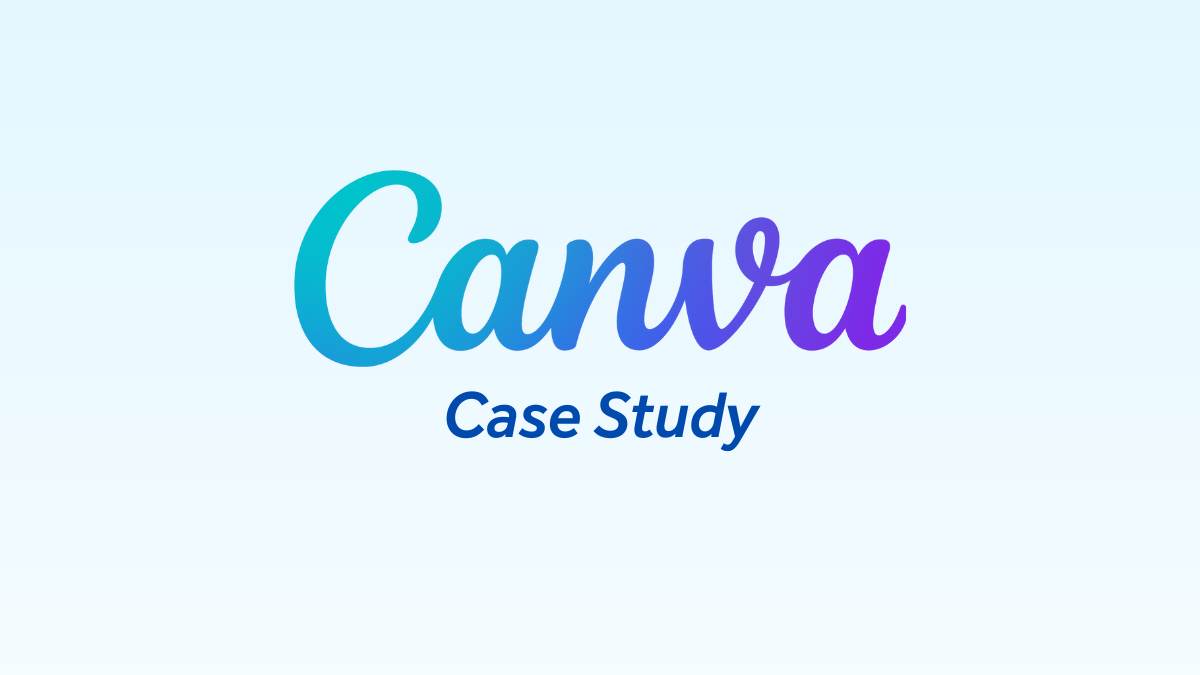If you’ve ever tried making a poster, a social media post, or even a pitch deck, chances are you’ve bumped into Canva. It’s pretty much everywhere these days. But Canva isn’t just a handy design tool, it’s one of the biggest success stories in the tech and marketing world.
This Canva Case Study isn’t just here to tell you how they made it big. It’s here because Canva’s journey is packed with lessons for anyone in marketing, business, or content creation. Especially if you’re someone who wants to build something online.
It’s easy to look at Canva now and think, “Of course it was going to succeed.” But the truth is, it didn’t start big. It started small, with one very specific problem, and a clever way of fixing it.
For marketers, entrepreneurs, creators, and honestly anyone making things online, studying Canva’s growth is like getting a free masterclass in product strategy and digital marketing done right.
Table of Contents
The Canva Story: From Idea to Global Phenomenon
Canva didn’t just pop up fully-formed one day. Its story is one of those classic startup journeys, part frustration, part hustle, and a bit of luck along the way.
It all started in Perth, Australia, where Melanie Perkins, Canva’s co-founder, was teaching students how to use graphic design software. The tools were complicated, expensive, and honestly… kind of intimidating for beginners. She thought, “Why isn’t there an easier way to do this?”
That thought stuck.
Melanie teamed up with Cliff Obrecht (now her husband and co-founder) and later Cameron Adams, who used to work at Google. Together, they started building the foundation of what would become Canva.
But before Canva, there was Fusion Books, an online tool for making school yearbooks. It was a smaller project, but it taught them a lot about online design and customization. Think of Fusion Books as Canva’s warm-up round.
Here’s how the timeline roughly played out:
- 2007: Fusion Books is born.
- 2012: They raise some early funding, Cameron joins the team.
- 2013: Canva officially launches.
- 2020: Canva becomes a unicorn, valued at over $6 billion.
- 2023: Canva Magic Studio launches with all the AI goodies.
- 2024: Over 135 million people are using Canva worldwide.
Not bad for an idea that started in a student classroom.
Canva’s Mission, Vision, and Core Values
If you really want to know why Canva works, you’ve got to start with why they built it in the first place.
Right from the start, their mission has been super clear: empower the world to design. It’s not just a slogan, they mean it. And that focus shaped everything they did, from the features they built to the community they grew.
They didn’t just want to make designing easier, they wanted everyone to be able to create beautiful things without needing expensive software or fancy skills. Basically, they wanted to break down the walls between professional designers and regular people with ideas.
That’s why Canva invested in things like free educational content, the Canva Design School, free plans for nonprofits, and tools for schools and students. It wasn’t just about building software, it was about building a movement around creativity.
The company’s values, simplicity, accessibility, inclusion, creativity, show up in every part of the product. And honestly, that’s what separates Canva from a lot of other tech tools. It’s not just a thing you use. It’s a thing you feel good using.
Also Read: Zara Case Study
Inside Canva: What Makes It So Popular?
Alright, so we know why Canva was created and what it stands for. But what’s actually inside Canva that makes it such a hit?
Let’s break down the parts that keep people coming back.
1. Tons of Templates for Pretty Much Anything
One of Canva’s biggest superpowers is how many templates it has. Want to make a birthday invite? There’s a template for that. Need a professional pitch deck? Yup, template. Instagram post, YouTube thumbnail, resume, you get the idea.
It’s kind of like having a designer on call, but without the awkward emails and invoices. And if you don’t know where to start, Canva gives you a head start with something that already looks good.
2. Collaboration That Actually Works
Ever tried working on a design with a team using email attachments? Yeah, not fun.
Canva lets multiple people work on the same design at the same time. You can leave comments, suggest edits, or just fix things as you go. For businesses with remote teams or even creators working with clients, this saves so much back-and-forth.
3. Brand Kit for Consistent Looks
If you’re working with a brand, or trying to build your own, keeping things consistent matters. Canva’s Brand Kit lets you upload your logo, set your colors, and lock in your fonts. That way, everything you make looks like your brand, not just a random template.
This is where Canva really moves from “helpful design tool” to “serious business tool.”
Also Read: Netflix Case Study
4. Videos and Animations? Yep, It Does That Too
The world loves video, and Canva didn’t miss that trend. You can make animated posts, simple videos, or even presentations that move in Canva. And you don’t need fancy editing skills to do it.
If you’re posting to TikTok, Reels, or YouTube Shorts, this feature alone might be the thing that keeps you using Canva regularly.
5. The Magic of Canva Magic Studio
Lately, Canva has been stepping into the AI world, and honestly, it’s impressive.
With Canva Magic Studio, you can do things like:
- Magic Write: Need help writing text for your post or presentation? Magic Write can draft it.
- Magic Design: Upload an image, and Canva gives you design ideas around it.
- Magic Eraser & Magic Edit: Want to remove something from your photo or tweak part of the design? It’s basically Photoshop-level editing, but easier.
Adding AI into Canva isn’t just a trendy move, it makes creating faster and smarter, especially for people who aren’t professional designers but still want great-looking content.
Also Read: Uniqlo Case Study
How Canva Grew: Strategy Behind the Success
Now, having a great product definitely helps, but Canva didn’t just get lucky. Their growth is the result of really smart strategy. Let’s break down how they actually pulled this off.
1. Freemium Model Done Right
A lot of tech products go for a freemium model, start free, then get people to pay for more features. But Canva nailed the balance.
They made the free version really good. Not crippled, not frustrating. Just solid. That made people trust the platform. And once someone started using Canva regularly, upgrading to Pro for extra features felt like a natural next step.
Then they introduced Canva for Teams, Canva for Enterprise, basically growing with their users as their needs got bigger. It’s one of the cleanest examples of how to use freemium to drive real growth.
2. Education-Based Marketing: Canva Design School
Here’s where Canva got even smarter. Instead of just saying, “Hey, look at our cool features,” they built an entire education platform to teach people how to design better. It’s called Canva Design School.
Why does this work? Because when people learn how to design better, they naturally want to use the tool that taught them. Plus, it builds loyalty. People don’t just use Canva, they feel connected to it.
And when users win, Canva wins.
3. SEO & Content Engine: Winning with Organic Traffic
Want to know a big reason why Canva is everywhere on Google? It’s because they’ve built a monster content strategy around SEO.
Search for things like “Instagram post size,” “business card template,” or “how to make a logo”, Canva is usually one of the top results. They don’t just make templates; they explain how to use them. And every helpful blog post or guide they publish pulls more users into their ecosystem.
One example: their keyword targeting around “free templates” brings in millions of visits a month. They basically built an entire library of helpful content that’s always working in the background to drive traffic.
4. Canva on Social: Brand Personality + UGC + Influencers
Let’s talk social media for a second. Canva’s social game isn’t just pretty posts, it’s strategy in action.
On Instagram, YouTube, and TikTok, they show off design tips, highlight community creations, and collaborate with influencers who already use Canva to build their own audiences. That’s clever, because it means Canva gets exposure to audiences that already trust the creators they follow.
They also lean heavily on user-generated content (UGC). When users share what they’ve made in Canva, Canva shares it too. It builds a feedback loop of creativity and visibility.
Also Read: Amul Case Study
5. Community & Creators: Affiliate and Contributor Ecosystem
Canva didn’t just build a product, they built a community. They pay contributors who upload elements, graphics, templates, and photos. That means creators are financially motivated to make Canva better.
They also run a strong affiliate program. People who love Canva recommend it, and get paid when others sign up. It’s a win-win.
This strategy grows Canva’s content library, keeps creators engaged, and turns regular users into brand advocates.
6. Real-World Proof: Canva for Teams & Case Studies
It’s not just freelancers and students using Canva anymore. Businesses of all sizes use it to streamline their content creation. They’ve got case studies showing how brands build entire workflows inside Canva.
One standout example is Zoom (yeah, that Zoom) using Canva templates to keep their visual branding on point during the pandemic. That’s the kind of real-world proof that makes other businesses go, “Alright, maybe we should get on this too.”
Also Read: Dunkin’ Donuts Case Study
Smart Marketing Lessons from Canva
If you’re in digital marketing, Canva is the brand to study right now. They hit that sweet spot of great product + smart community-building + content marketing done right.
Here’s the part where I’m gonna be a bit direct: if you want to learn how to build strategies like this, you need to start learning digital marketing properly, not just surface-level, but the real stuff like growth strategies, SEO, paid ads, and community marketing.

Want to learn the exact strategies brands like Canva use to grow globally? Check out the Digital Marketing Course by Young Urban Project. We break down stuff like this step by step, with real examples you can actually use.
Don’t just watch Canva win; learn how to build your own success story.
Top Canva Tips & Tricks for Power Users
Want to get more out of Canva? These tips are for you. If you’re already using Canva regularly, these features and shortcuts will help you work faster, smarter, and with a lot more creativity.
1. Bulk Create Designs with Data
The Bulk Create feature in Canva lets you make dozens—or even hundreds—of design variations in no time. Just upload a CSV or Excel file with your content, link the data to your design, and Canva takes care of the rest. It’s perfect when you’re creating loads of social posts, certificates, business cards, and more.
2. Harness AI-Powered Tools
Canva’s AI tools can seriously speed things up:
- Magic Resize: Quickly adjust your designs to fit different platforms.
- Magic Edit & Magic Eraser: Edit or remove parts of an image using AI.
- Magic Write: Generate text for your designs.
- Background Remover & Magic Expand: Clean up images or expand beyond the original size.
3. Master Keyboard Shortcuts
If you want to save time, keyboard shortcuts are your friend:
- Cmd/Ctrl + G: Group elements.
- Cmd/Ctrl + Shift + K: Change text case.
- Cmd/Ctrl + ] or [: Move layers forward or backward.
- T, R, C, L: Add text, rectangles, circles, or lines instantly.
- Option/Alt + Drag: Resize elements from the center.
Also Read: Starbucks Case Study
4. Use the Brand Kit for Consistency
Keep your branding sharp and consistent by setting up your Brand Kit in Canva Pro. Upload your logos, fonts, and color palettes once—and apply them across every design with just a click. No more manually adjusting everything every single time.
5. Advanced Collaboration & Version Control
With Canva’s collaboration features, you and your team can work on the same design at the same time, leave comments, and assign tasks. Plus, version history lets you track changes and go back to earlier versions if needed. No more worrying about losing important edits or feedback.
Also Read: McDonald’s Case Study
Canva vs. Competitors: What Sets it Apart?
Let’s be real, Canva’s not the only game in town. Tools like Adobe Express, VistaCreate, and Figma (especially for team-based design) are out there too.
But why does Canva usually win for most people?
Because it’s easy. It feels fun. It’s not intimidating. Even someone who’s never designed anything before can make something cool in Canva within five minutes. That low barrier to entry matters more than having every advanced feature.
If you’re a professional designer, maybe you lean toward Adobe. But for most marketers, content creators, and small businesses? Canva just makes sense.
Also Read: Coca-Cola Case Study
Conclusion: What You Can Learn from Canva’s Success
Canva’s growth isn’t just about having a good product, it’s about solving a real problem in a way that makes people’s lives easier. They didn’t stop at design tools. They built a whole community, taught people how to use their product, and kept improving based on what users actually needed.
It’s a reminder that the best marketing often starts with creating something genuinely helpful. Canva didn’t rely on tricks or shortcuts. They focused on long-term value, smart education, and making design fun, even for people who never thought of themselves as creative.
Whether you’re running a business, building your personal brand, or just trying to work smarter, there’s a lot to learn from how Canva did it. Start with solving a problem, and then build around that. Simple works.
Also Read: Apple Marketing Case Study
FAQs: Canva Case Study
1. How did Canva become so popular?
Canva became popular by making graphic design super easy for regular people. Their free plan, combined with templates for basically everything, made it an obvious choice for beginners and businesses alike.
2. Is Canva suitable for professional designers?
It depends. Professional graphic designers might prefer Adobe tools for complex work, but Canva is great for quick projects, marketing materials, and social media graphics.
3. What is Canva Magic Studio, and how does it work?
Canva Magic Studio is a set of AI-powered tools that help with writing, editing images, and generating design ideas automatically. It’s like having an assistant inside Canva.
4. How does Canva use SEO to grow its traffic?
They create tons of helpful articles around design topics and keywords. Every blog post brings more people to their site, and many of those people end up using Canva to solve their design problems.
5. Which brands or businesses use Canva successfully?
Brands like Zoom, HubSpot, and small startups all use Canva for everything from social posts to branded presentations.
6. Canva vs. Adobe Express: Which one is better for marketers?
For most marketers, Canva is better because it’s easier to learn and faster for creating everyday content. Adobe Express has great features too but comes with more of a learning curve.

